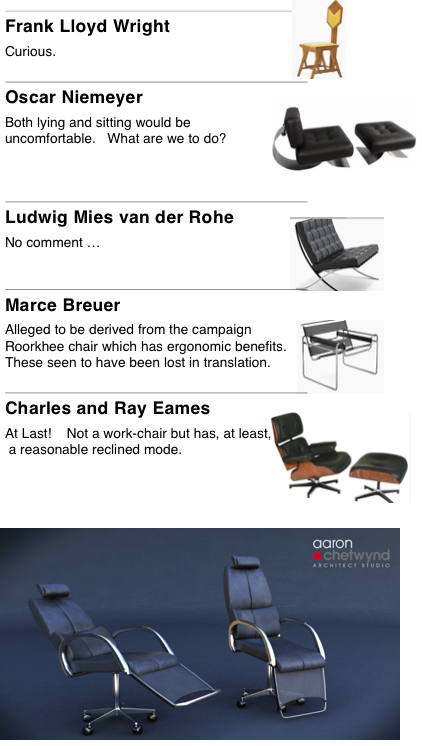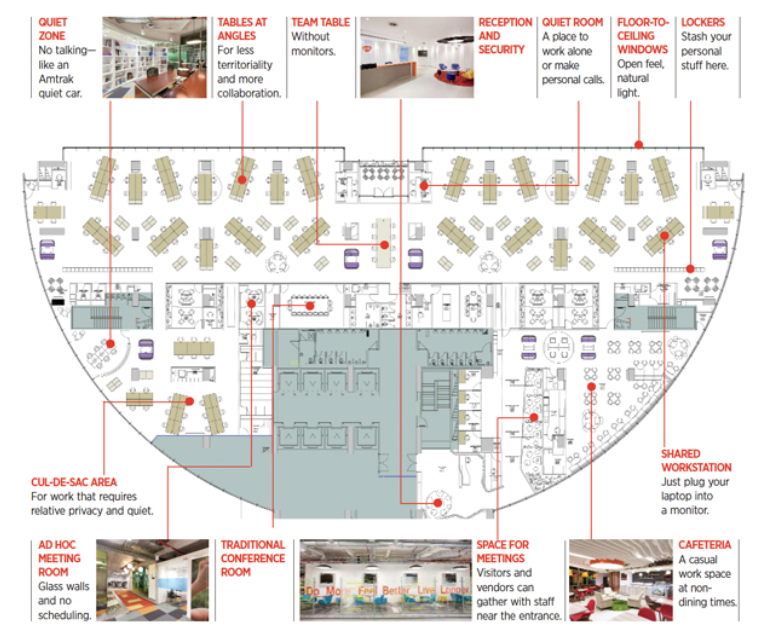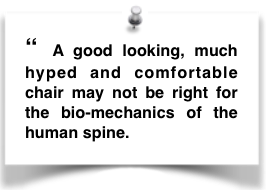Architects & office chairs. For New offices ‘Coolness’ is the word to excite media interest for both the company and for Architects or Designers. Most firms aspire to project this cutting edge image. A 2T chair answers this exactly and in addition reduces LBP and increased productivity by lessening stress and morbidity.
Many distinguished architects have tried their hand at chair design.
A few examples are shown.
 Great architects, as can be seen from their efforts, have been sorely lacking in knowledge of ergonomics when it is only ergonomics that determines comfort and avoids harm to the spine.
Great architects, as can be seen from their efforts, have been sorely lacking in knowledge of ergonomics when it is only ergonomics that determines comfort and avoids harm to the spine.
See also how they have muddled the ergonomic advantages of the Roorkee chair. However, bright young architects already see the point. This early example by Aaron Chetwynd was much admired. Deliberately looks traditional so as not to excite Familiarity Bias, and frighten the horses. With only a few minor design alterations it is ready & suitable for a 3 or 4M model.
Architects play an important part in development.
They are able to dictate requirements for projects. Ergonomic knowledge becomes vital to avoid stipulating work chairs with potentially harmful outcomes.
THE RELEVANCE OF THE 2t (3M, 4M) concept
All the relevant factors are ticked :-
![]() A CONCEPT only allowing INDEPENDENT DESIGN. Based on the bio-medical evidence, provides a template for optimising the ergonomics of chair design.
A CONCEPT only allowing INDEPENDENT DESIGN. Based on the bio-medical evidence, provides a template for optimising the ergonomics of chair design.
![]() Based on the scientific bio-medical research it identifies & remediates each & every adverse effect of the upright work position responsible for musculo-skeletal discomfort which include backache, LBP, and more serious spinal breakdown. The only solution to do this ☛ 2T CONCEPT a full solution
Based on the scientific bio-medical research it identifies & remediates each & every adverse effect of the upright work position responsible for musculo-skeletal discomfort which include backache, LBP, and more serious spinal breakdown. The only solution to do this ☛ 2T CONCEPT a full solution
![]() Maximises comfort. This depends on the ergonomics and NOT on short term opinion. Fully correct ergonomics = maximum comfort. →
Maximises comfort. This depends on the ergonomics and NOT on short term opinion. Fully correct ergonomics = maximum comfort. →
![]() Provides dynamic MOVEMENT under the control of the user. Affects health & comfort and also has a rehabilitation use ☛EXERCISE & movement→. ☛ The unstable TRANSITIONAL MODE. It’s importance. →
Provides dynamic MOVEMENT under the control of the user. Affects health & comfort and also has a rehabilitation use ☛EXERCISE & movement→. ☛ The unstable TRANSITIONAL MODE. It’s importance. →
![]() Reduces manufacturing costs. Correct design avoids expansive confusing adjustments →
Reduces manufacturing costs. Correct design avoids expansive confusing adjustments →
![]() Subsidiary factors include relevance to the modern and future office environment, cost, brand image and user targeting.
Subsidiary factors include relevance to the modern and future office environment, cost, brand image and user targeting.
![]() Evolves easily into deskless ☛OFFICE WORK-STATIONS → particularly relevant to the coming AI, VR & MR developments.
Evolves easily into deskless ☛OFFICE WORK-STATIONS → particularly relevant to the coming AI, VR & MR developments.
![]() A PARADIGM shift. The way ahead? It is already happening! The boundaries between contract and home furniture are decreasing and the division may be disappearing entirely. The only problem is that no such chair exists yet in the market. An opportunity for someone?
A PARADIGM shift. The way ahead? It is already happening! The boundaries between contract and home furniture are decreasing and the division may be disappearing entirely. The only problem is that no such chair exists yet in the market. An opportunity for someone?
Office ergonomics
Poor seating is a major stressor resulting in reduced performance and absenteeism. (☛OFFICE HEALTH, Stress & Ergonomics ) and is of importance for Architects. At present I know of no chair in the market that fully remediates this. New seating concepts are coming forward which will not only revolutionise seating but also impact on office design. In a few decades a chair set before a desk, and arranged in straight lines will be perceived as not only dated but hopelessly inefficient. There is an increasing interest in this direction (☛WORK-CHAIRS, a new breed with a reclined mode. ) Also see Mindjet which with much hype describes GlaxoSmithKline’s purposed “deskless office” below. ‘Great it ain’t’ but shows the way things are going.
The designers of this layout obviously did not have the benefit of having seen the work of John Jukes described in ☛OFFICE HEALTH, Stress & Ergonomics⇒ which were tested in the field but has not been universally adopted. His recommendations for Office Environment Optimisation achieve lower staff stress levels and higher productivity. For a discursive account See Office environment stressors→
Peter Bessey wrote to me “Desks are rather a thing of the past – Dickensian even. They evolved as tables with storage developed, alongside chairs. The whole combination seems a way of reducing/avoiding the need for floor sitting or squatting and a means to provide a convenient standing/sitting presentation of objects for working with at an ergonomically higher level. They were there to support and present paper documents and the like. Hardware, since then, was largely developed to be used with/on them and has evolved through typewriters and similar devices to today’s electronics. Once that demand for physical documents has been reduced and even eliminated by ‘paperless’ office tech., then there is once more a blank page to draw on.”
FOR INTERIOR DECORATORS
 The 2T (3M or 4M) derivatives) are the systems of choice for office and longterm home activities such as Gaming, and potential for sleep. Ergonomics that avoid harmful effects are paramount and secondarily ensure maximum comfort..
The 2T (3M or 4M) derivatives) are the systems of choice for office and longterm home activities such as Gaming, and potential for sleep. Ergonomics that avoid harmful effects are paramount and secondarily ensure maximum comfort..
In the home sitting is less prolonged and less stringent ergonomic requirements can be allowed. ☛ EASY CHAIRS . It is still advisable for ergonomic adverse chairs be avoided.
 For a discursive account→
For a discursive account→
Comment
Dear Henry
Very good account.
Good environmental design for offices must include ergonomics of the workplace to lessen musculoskeletal problems which are common and cause a high degree of absenteeism as well as low productivity. Field trials have shown how a good chair perhaps costing more initially improves the health of the occupant, increases their productivity and decreases the risk of absenteeism.
Derek
Professor D Clement-Croome
Professor Emeritus in Architectural Engineering at the University of Reading
